Embedded Systems Statistics By Market Size And Technologies
Updated · Jul 02, 2025
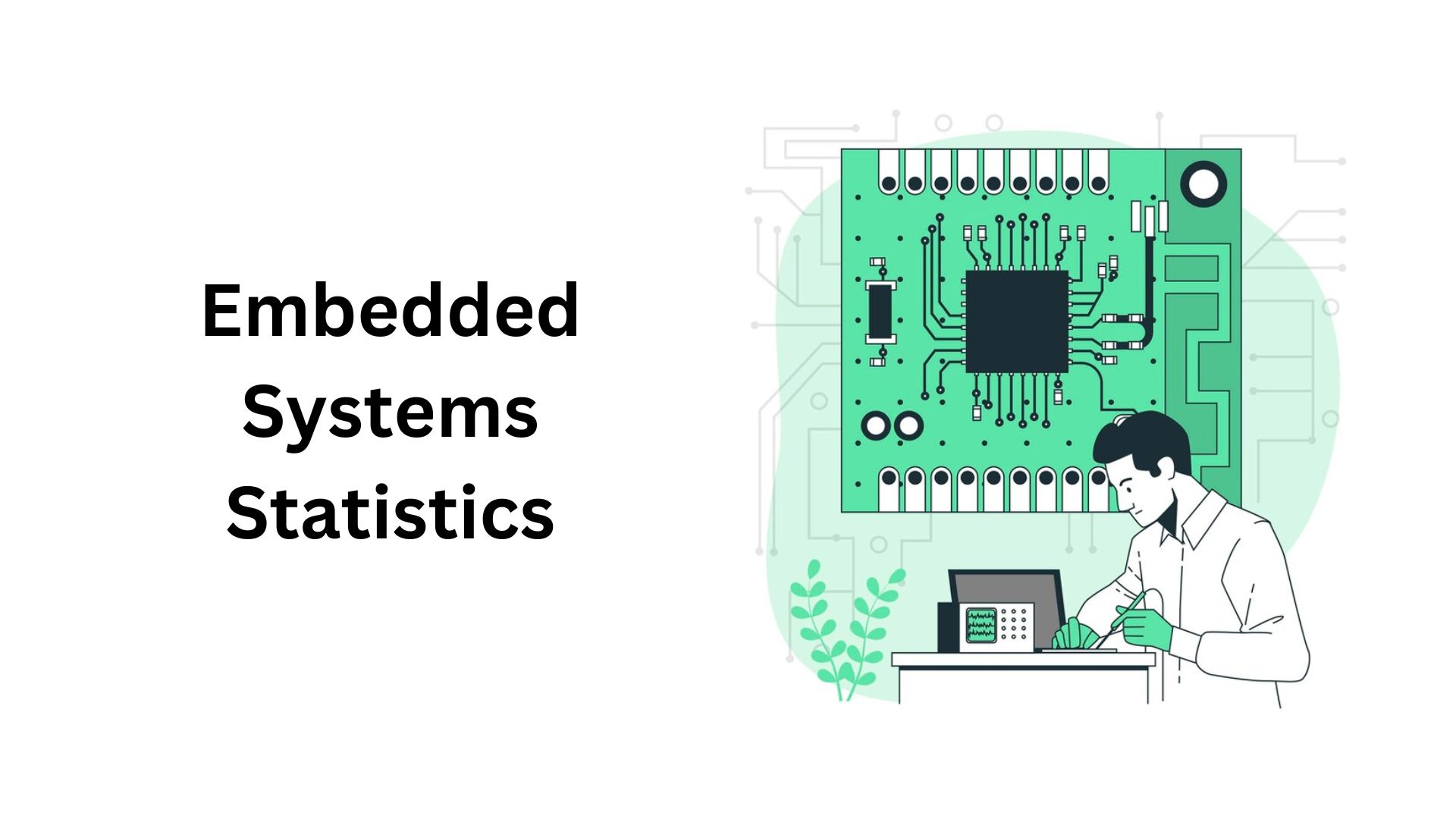
Table of Contents
- Introduction
- Editor’s Choice
- Embedded System Market Size
- Embedded Systems Technologies
- Embedded Systems Projects
- Embedded Systems Development Makes Use Of Advanced Technologies
- Most Popular Embedded Systems OS
- Market Share Of Industrial Embedded Systems In China
- Embedded Systems Technologies Developments
- Embedded Systems Market By Region
- Challenges Of Embedded Systems
- Conclusion
Introduction
Embedded Systems Statistics: Embedded systems are specialized computing units operating a dedicated program within larger mechanical or electrical systems. Embedded systems are integral to many applications; from consumer electronics and automotive systems to industrial automation and healthcare devices. The embedded systems industry has seen magnificent growth as of 2025 due to technological advancements, product demand for smart devices, and the vast spread of the Internet of Things (IoT).
This article discusses Embedded Systems statistics currently being witnessed in the embedded systems market, highlighting figures worth noting, drivers of growth, and projections for the future.
Editor’s Choice
- The embedded systems industry is projected to be worth US$178.15 billion in 2024 and is expected to reach US$283.90 billion over the next decade by 2034, with a CAGR of 4.77%.
- Raspberry Pi stands big as the most common embedded technology, with 39% of developers using or intending to use it. Other tools that get attention are Arduino, GNU GCC, and CMake.
- According to Embedded Systems statistics, Embedded system projects are dominated by industrial control and automation (29%), followed by IoT (24%), communications (21%), and automotive (19%).
- Embedded AI accounts for 50% of interest among those advanced technologies, followed by machine learning (47%) and embedded vision (36%).
- The majority of developers in 2024 will be using Embedded Linux and FreeRTOS, with both operating systems being adopted by 44% of developers. Ubuntu, Debian, and Android round out the list of the most used.
- Huawei owned about 16% of China’s industrial embedded software market in 2019.
- Embedded Systems statistics state that Bluetooth Low Energy (LE) Audio will enhance Bluetooth device shipment up to 7.6 billion by 2027 at a growth rate of 9% annually.
- Ultra-wideband (UWB) audio is also arising for confronting Bluetooth’s low consumption and high data transfer rate.
- Matter is an open-source smart home standard gaining traction among heavyweights such as Google, Apple, Samsung, and Ikea.
- The North American region holds the top share in the embedded systems market at 51%, whereas Europe and the Asia Pacific follow with 24% and 16% shares, respectively.
- Embedded systems also face security threats by cyberattacks and DDoS types, thus necessitating strong security measures.
Embedded System Market Size

(Reference: precedenceresearch.com)
- Embedded Systems statistics estimated the value of approximately US$178.15 billion will be the embedded systems market by 2024.
- Over the next decade, the market is expected to grow to reach about US$283.90 billion in 2034.
- It would mean an average market expansion rate from 2024 to 2034 of 4.77% per year.
- Increases in demand for smart devices, IoT applications, and automation in sectors such as healthcare, automotive, and consumer electronics drive growth.
- As technology continues to advance, everyday goods and industrial processes will have embedded systems even more essential.
Embedded Systems Technologies
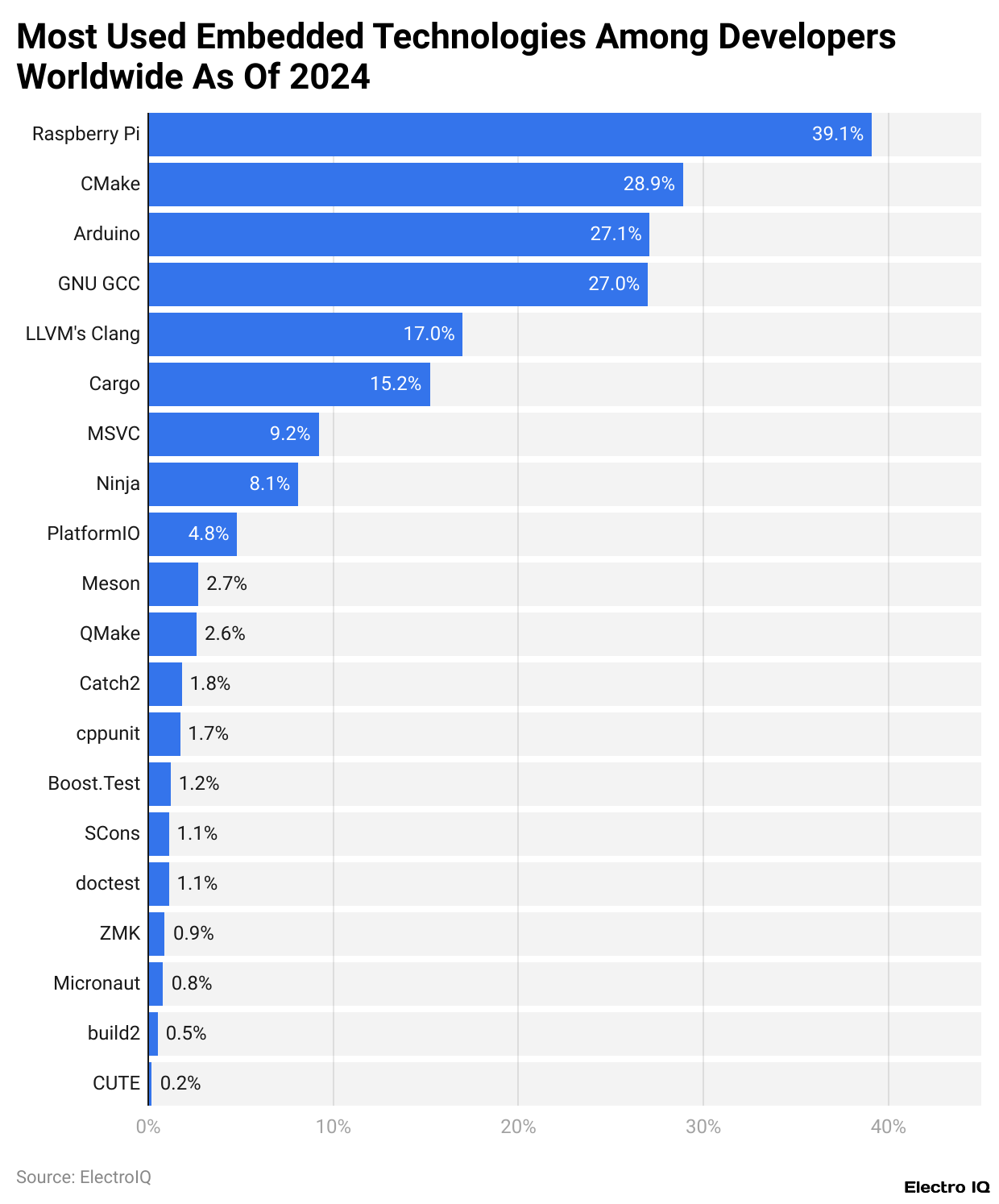
(Reference: statista.com)
- Embedded Systems statistics show that in 2024, Raspberry Pi was by far the dominant platform for embedded technologies among developers worldwide.
- Around 39% of developers report having either used it for a project in the preceding year or planning to use it in the immediate upcoming year.
- This places Raspberry Pi high on the list of embedded system development environments.
- Other technologies that developers often engage with include Arduino, GNU GCC, and CMake, the acknowledged artisans of the embedded systems craft.
Embedded Systems Projects
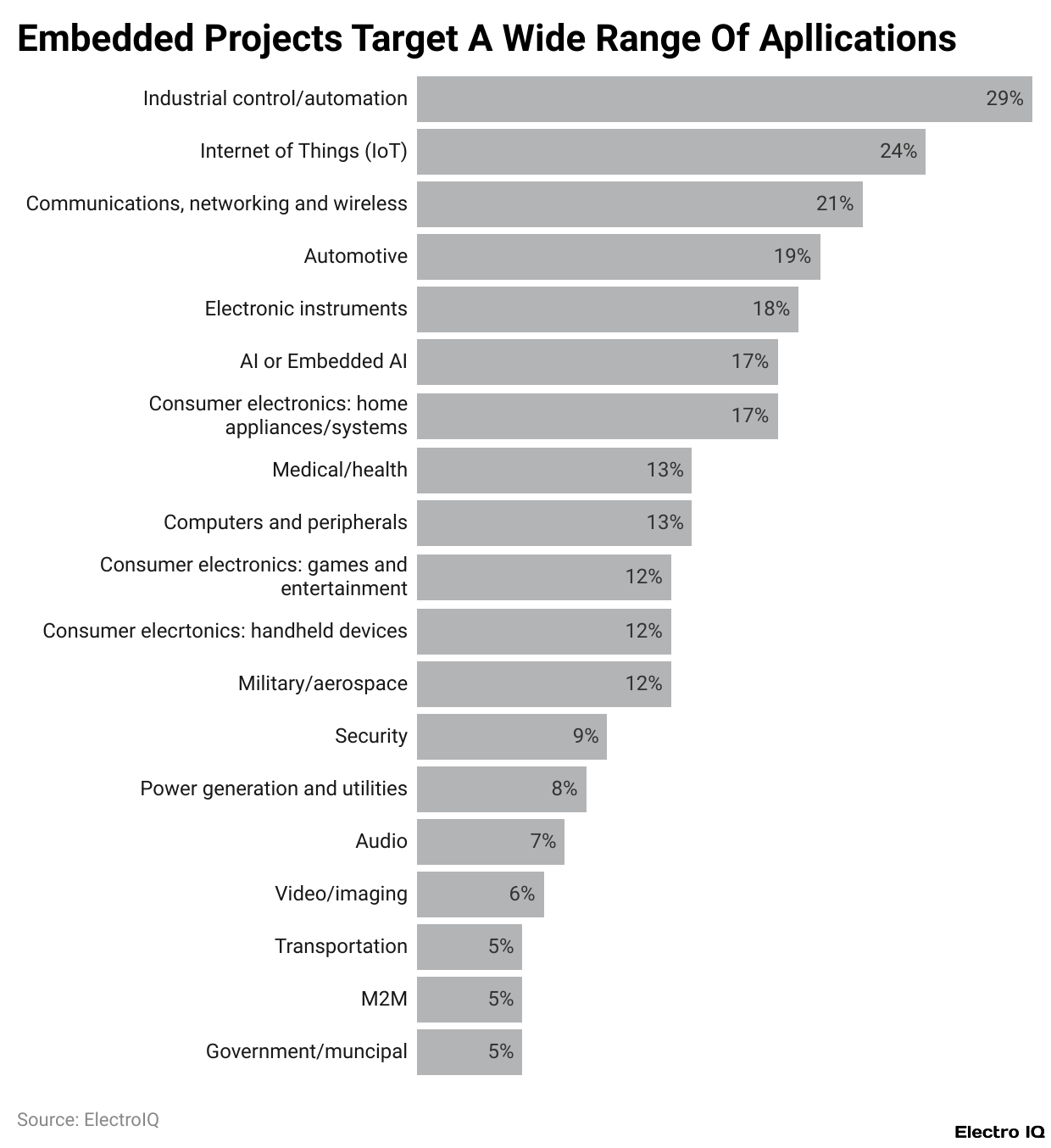
(Reference: embedded.com)
- Embedded systems could serve as the basis of many different completed projects in developing fields and areas, the largest being industrial control and automation areas, which keep up 29% of the projects. This includes factory machines and automatic processing operations.
- The second best application was the IoT at 24%. Consumer products connect and communicate through the internet with each other.
- Embedded Systems statistics reveal that Communications, networking, and wireless account for 21% of projects and are largely focused on such technologies as Wi-Fi, Bluetooth, and 5G.
- 19% comprised projects related to automotive, where more technologies have been associated with cars such as engine control and introduction of driverless features.
- 18% included electronic instruments like measuring devices and testing equipment.
- Embedded AI and AI were present in 17% of projects, often making smart devices work smarter as their input format. An equal number participated in consumer electronics comprising appliances and systems such as smart thermostats as well.
- 13% were related to the field of the medical and the health-related embedded systems that made use of hospitals from the equipment to the wearable health monitors.
- Also representing 13% were computers and their peripherals, including keys, printers, and storage devices. Consumer electronics, including games, entertainment, and personal devices such as smartphones, also represented part of the population at 12%.
- Some military and aerospace applications also accrued this same part of the contribution, as they were much more inclined toward defense and aviation technology.
- 9% were made up of security-related embedded systems and were used in surveillance cameras, alarms, and cybersecurity tools.
- 8% made up power generation and utilities, including but not limited to smart grids and energy monitoring. 7% only projected sounds, such as sound processing or even smart speakers; video and imaging technologies, from cameras to displaying them, were composed of 6%.
- Among the other systems for transportation, like railway and traffic management, the amount of machine-to-machine (M2M) communication accounted for 5% of the total.
- This same percentage belonged to public and municipal projects that might involve public infrastructure and smart city applications.
Embedded Systems Development Makes Use Of Advanced Technologies
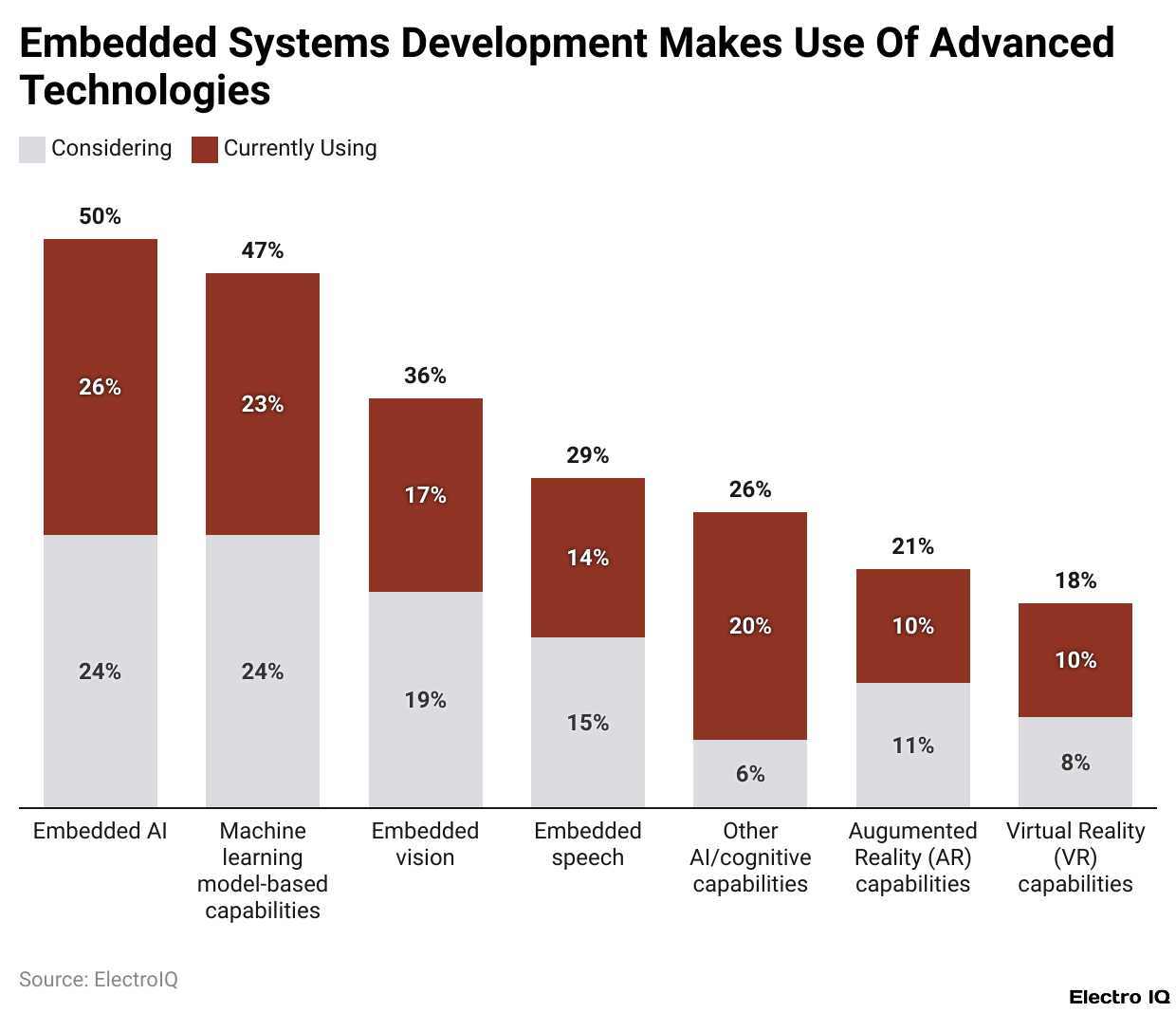
(Reference: embedded.com)
- In embedded system development, cutting-edge technologies are of interest to embedded system developers.
- Embedded Systems statistics state that Embedded AI is subscribed by more than half of the developers, while 50% are interested in it. Of that percentage, 26% do use it while 24% are evaluating it. Also popularly used is model-based machine learning, which has 47% (23% actively using it, 24% considered) interest.
- Embedded vision technology records a total of 36% interest, with 17% now using it and 19% considering it. The next one is embedded speech technology, which has a total of 29% interest, with 14% currently using it and 15% considering it.
- Other AI or cognitive capabilities recorded 26% overall interest, with only 6% considering it while 20% are presently using it.
- Augmented Reality (AR) capabilities have a total of 21% interest, of which 10% use it currently and 11% consider it.
- The capabilities of Virtual Reality were slightly lower, with 18% saying they are interested, 10% already using it, and 8% considering it.
Most Popular Embedded Systems OS
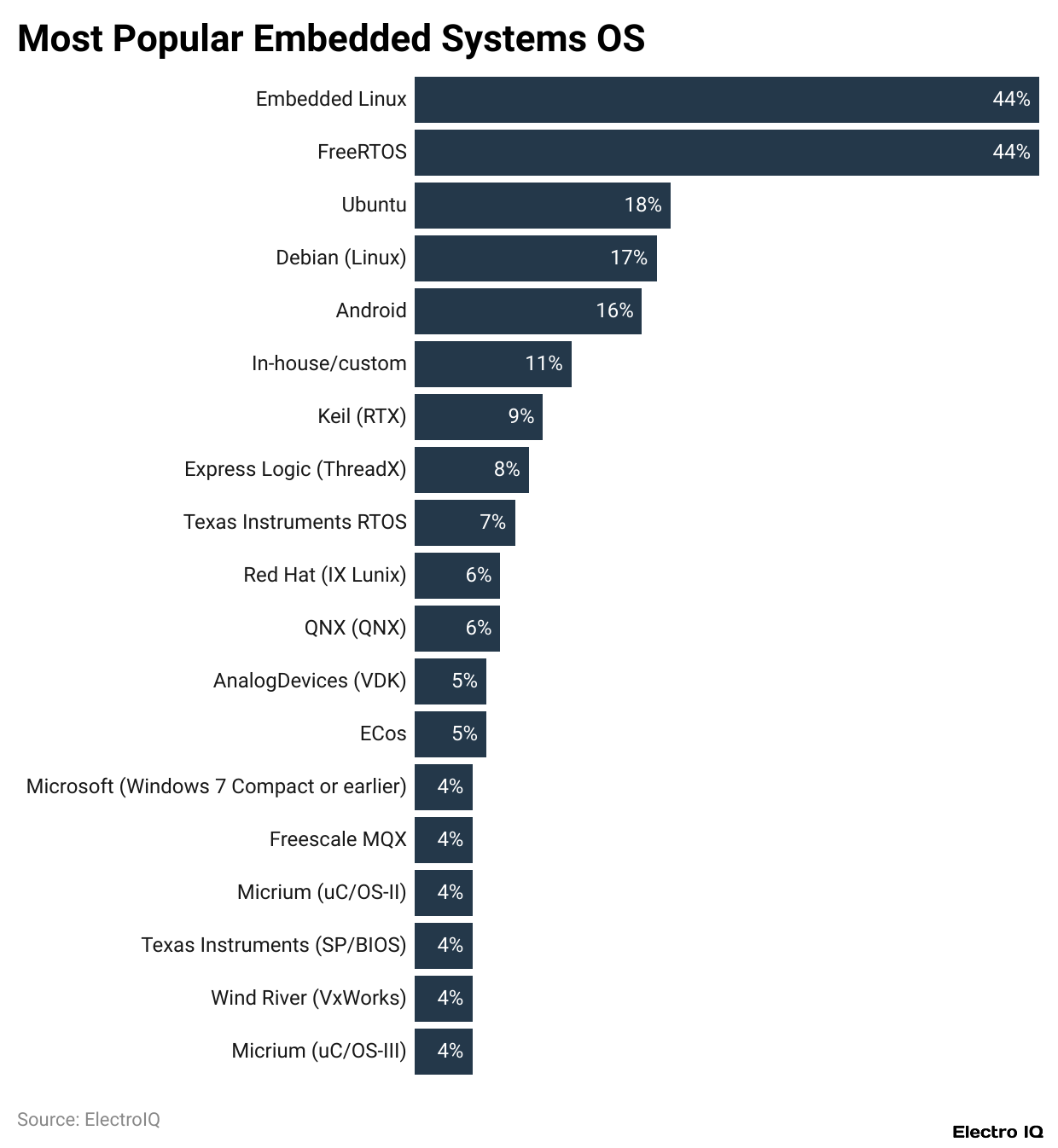
(Reference: embedded.com)
- The two operating systems that were most popularly used in 2024 for embedded systems were Embedded Linux and FreeRTOS. At this time, an equal percentage of developers (44% each) had utilized both options.
- Embedded Systems statistics indicate that Embedded Linux and FreeRTOS are very much preferred by developers as these systems are flexible and reliable for many applications.
- Ubuntu came much later at 18%, whereas Debian (also another Linux-based system) had a representation of 17% among developers.
- Android also registered a very close 16%, showing its relevance in embedded technology.
- 11% of developers preferred their operating systems, building custom for their needs.
- Among the other options were Keil RTX (9%), Express Logic ThreadX (8%), and Texas Instruments’ RTOS (7%). After these, small cohorts of developers were reported to work on Red Hat IX Linux (6%), QNX (6%), and Analog Devices VDK (5%).
- About 4% to 5% of developers were used to the following operating systems: ECos, Freescale MQX, Microsoft Windows 7 Compact (or earlier), Texas Instruments DSP/BIOS, Micrium UC/OS-II and UC/OS-III, and Wind River VxWorks.
- This proves that indeed systems based on Linux were in the majority, though many different kinds of operating systems exist based on varying project requirements and specific hardware configurations.
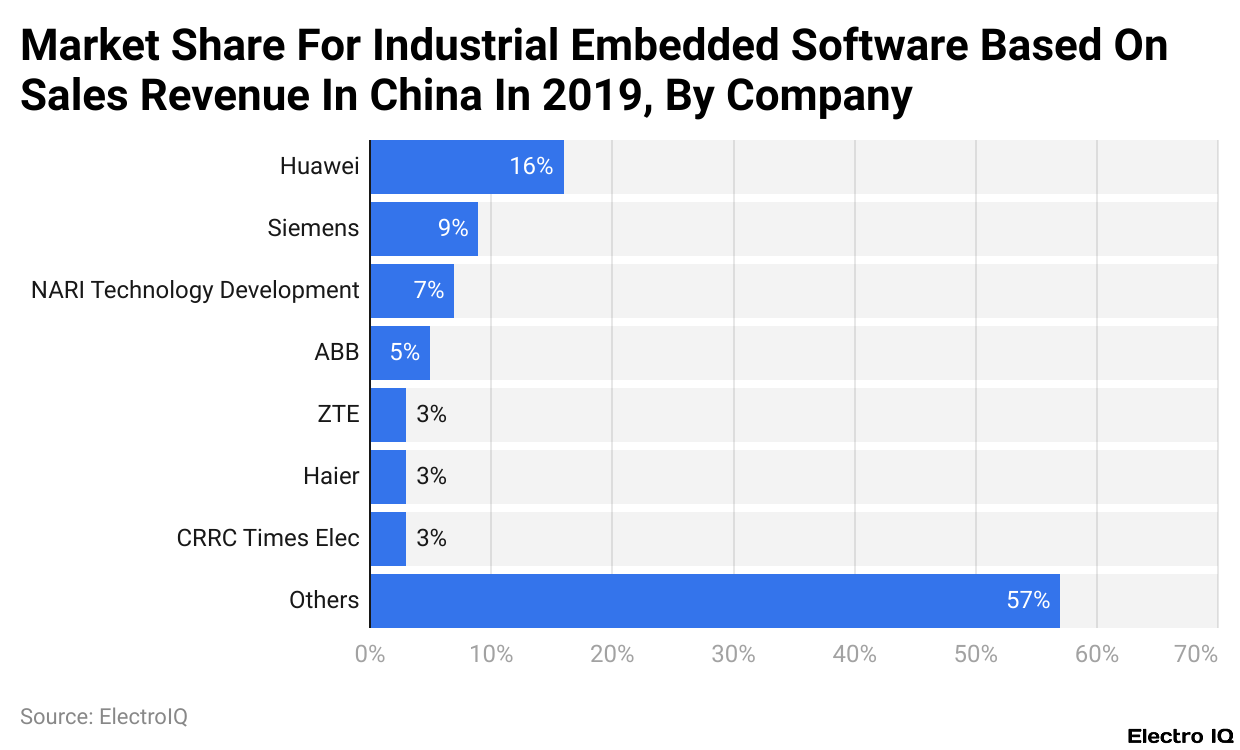
(Reference: statista.com)
- According to Embedded Systems statistics, Huawei’s sales revenues accounted for an estimated 16% of the industrial information management software market in China in 2019.
- Industrial software is used by factories and businesses, also research, manufacturing, and quality control for their internal applications.
- Huawei was one of the leaders in this area and provided software solutions for efficient use of industries.
Embedded Systems Technologies Developments
- Embedded Systems statistics show that transmission through low-power radio instead of the conventional Bluetooth signal, thus enabling faster transmission with less complexity and optimized memory consumption.
- This could be practically used in public announcements at train stations and malls, real-time translations for international events, and entertainment in gyms.
- The SIG predicts that coupled with the advantages it has, Bluetooth device shipments will reach 5.4 billion in 2023 and rise to 7.6 billion by the year 2027, with an average annual growth rate of 9%.
- Ultra-wideband (UWB) audio makes it possible to transfer large amounts of data over short distances with only one-tenth the power Bluetooth requires. This technology could be a fantastic alternative to music cables for headphones and other similar short-range audio connectivity.
- Matter is a universal standard that allows easier connections between smart home devices and IoT products. Since it is open-source, different brands will be able to use this to share their products.
- The support of Matter is given by major companies like Google, Apple, Samsung, and Ikea.
- The following are the products that are undergoing this standardization: special logo indication. This will broaden the simplicity, reliability, and strength of security for ease of use, stable, and responsive local connections, so more companies turn to adoption in the future.
Embedded Systems Market By Region
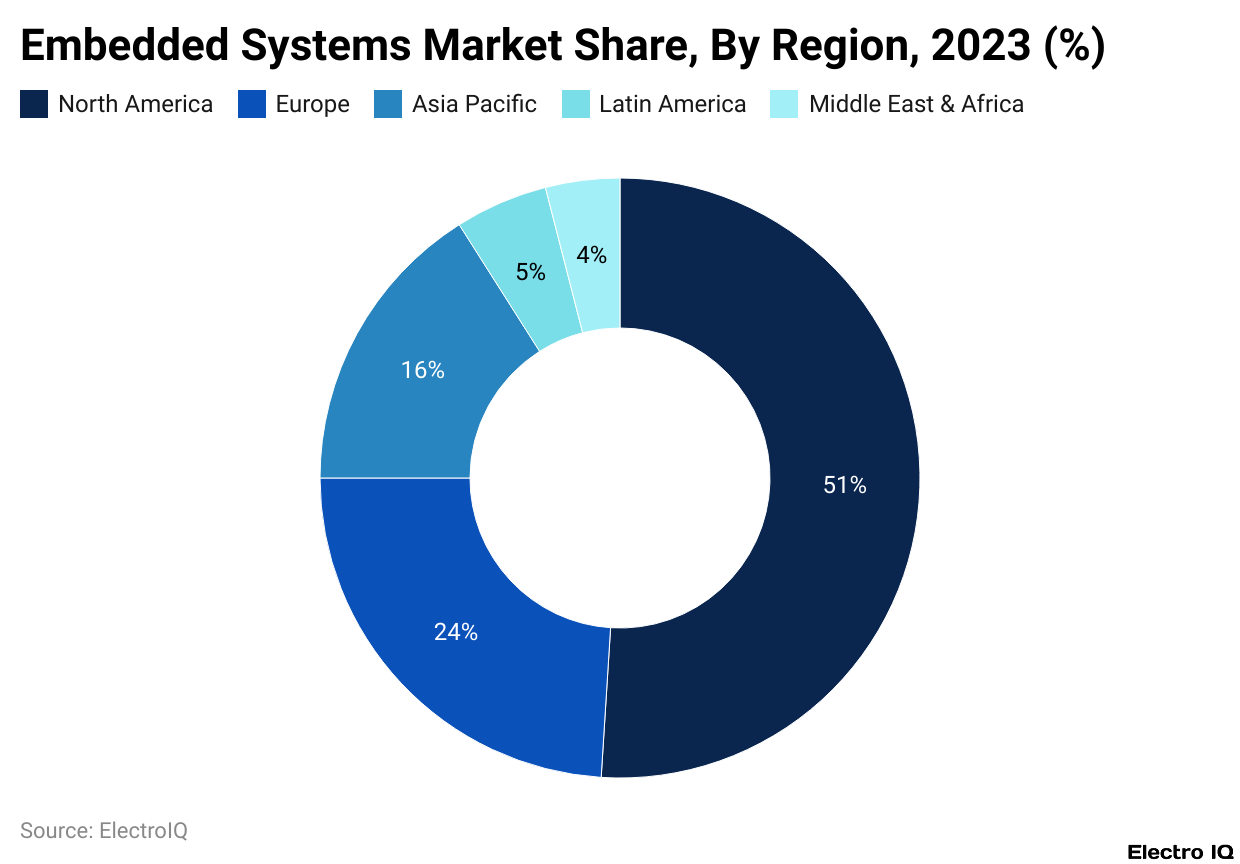
(Reference: precedenceresearch.com)
- According to Embedded Systems statistics, in terms of no geographic discrepancies across years, it was North America in 2024 that attained the highest proportion in the embedded systems market, recording 51% of the total.
- This was followed by Europe with 24% as many industries within automotive and manufacturing use embedded systems.
- Asia Pacific accounts for 16% because of its fast industry growth as well as an increasingly power-hungry demand for “smart-” technology.
- “Latin America had a much smaller piece, just 5% and the remaining Middle East and African countries had only 4%,” which of course indicates an emerging but less dominant market.
Challenges Of Embedded Systems
- Cybersecurity Threats and Hacking: All technologies face the risk of cyber-invasions, especially with cybercrime now being increasingly expanding in scale, complexity, and means. Embedded systems, however, stand even at a greater risk. Weak security in connected hardware may also have the potential of propagating an attack against its very own logic, as internet-enabled devices are also vulnerable to being executed in DDoS attacks. Heavy security, which should be continuously updated and guaranteed, must be implanted during the system design itself for the sake of protection for embedded systems.
- Compatibility With Established Technology: Since there is no universal standard in embedded systems, interfacing different hardware and software becomes a tedious task. When different makers and developers produce products using different communication protocols, the issue of compatibility comes in interfering with the installation of new devices into an existing arrangement. At the firmware level, the problem can be addressed through a layered approach, and this may help separate low-level hardware from application code. This enables easy updates and compatibility changes without large-scale redesigning. At the hardware level, designing systems with modular components will help ensure compatibility by making it easier to replace or upgrade parts as technology changes.
- Change and Evolution: Embedded systems technology evolves at such a rapid pace that some implementations become outdated even before complete fielding. Thus, it is vital to consider integrating new developments into the design for evolution, not obsolescence and total replacement. Constantly replacing old systems with new ones becomes very costly, demanding enormous time and effort while causing disruption. In its turn, modular design provides a cushion in future-proofing embedded systems. It allows for different assembly variations, meaning products can be adapted easily when certain components become unavailable or better alternatives emerge.
- Expenses and Maintenance: The development, deployment, and maintenance of an embedded system require skills beyond simple programming. Engineers will use different tools such as microcontrollers, oscilloscopes, and application processors, depending on the requirements of the project. Maintaining low costs is especially vital for products manufactured in mass quantities. Cost-cutting strategies may include using single-layer printed circuit boards (PCBs) in a few designs to minimize material and manufacturing expenses.
Conclusion
The Embedded Systems statistics Dynamics and Trends depict a lively and mutable scene, with thriving developments, techno advancements, and applications embracing almost all kinds of industries. With escalating acts of interconnecting everything, the embedded system is now widely presumed to be an increasing area of application for enhanced functionality and efficiency in both simpler devices and more complex industrial systems. These are the ones that are challenging due to development costs and cybersecurity issues.
Anyway, current trends include innovations and the entering of growing technologies into embedded systems, and here is the promising future ahead for the concern.
FAQ.
The embedded systems market size is expected to stand at US$178.15 billion in 2024, with an anticipated compound annual growth rate (CAGR) of 4.77% between 2024 and 2034 to reach around US$283.90 billion by 2034. Growth is anticipated on the trends of increasing demand for IoT devices, industrial automation, and smart technologies.
Raspberry Pi is regarded as the top embedded technology in 2024, where 39% of embedded developers have either used it or planned to use it. Among the remaining popular tools in embedded projects are Arduino, GNU GCC, or CMake.
The most expected applications of embedded systems go in industrial control and automation (29%), followed by IoT (24%), communications and networking (21%), and automotive applications (19%). Other fields include consumer electronics, medical devices, and AI-based embedded applications.
The most common embedded operating systems in 2024 are Embedded Linux and FreeRTOS, both of which are used by 44% of developers, followed by Ubuntu (18%), Debian (17%), and Android (16%). There are also quite a number who operate their projects on an in-house-built OS.
Major challenges include security risks (attacks via the Internet and denial of service), incompatibility with hardware/software, broad technical advancement leading to obsolescence, and exceedingly high development costs. Solutions encompass modularity, industry standards, and robustness in security.

Joseph D'Souza founded ElectroIQ in 2010 as a personal project to share his insights and experiences with tech gadgets. Over time, it has grown into a well-regarded tech blog, known for its in-depth technology trends, smartphone reviews and app-related statistics.










